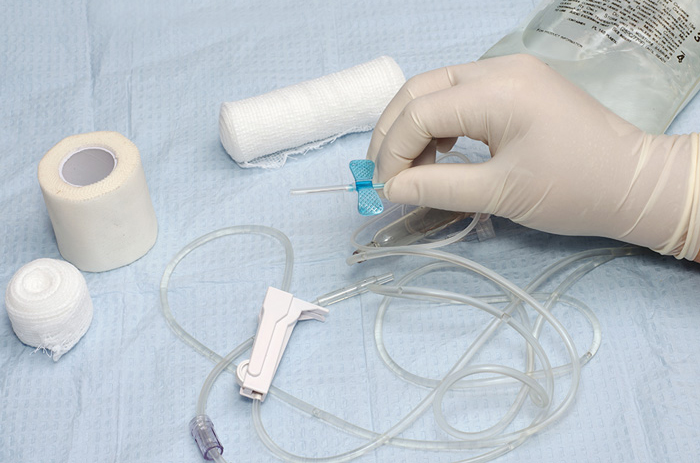Safety-engineered devices: technique progress
 EU directive 200/32 was implemented one year ago. It introduced fundamental preventive measures to avoid exposure to pathogen risk, such as forbidding recapping needles with devices that are not safety-engineered and making the use of safety-engineered devices a legal requirement.
EU directive 200/32 was implemented one year ago. It introduced fundamental preventive measures to avoid exposure to pathogen risk, such as forbidding recapping needles with devices that are not safety-engineered and making the use of safety-engineered devices a legal requirement.
The importance of assessing and preventing risk has been long documented, starting with OSHA data, according to which every year around 1 million sharps injuries take place, amounting to 800,000-5,120,00 costs.
Accidental sharps injuries for healthcare workers can be prevented. It is just necessary to:
- Put into place standard precautions, such as the WHO recommendations on hand-washing; indeed standard precautions can already reduce the frequency and the consequences of exposure to biological risk.
- Develop, validate and introduce safer operational procedures;
- Asses, adopt and use safety-engineered devices, after the staff has received proper training on how to use them
- Raise awareness among healthcare workers, inform them and give them the necessary training, on risk, using personal and collective protective equipment, the importance of reporting incidents and on the duties and rights of each worker (People for Healthcare Administration, Safety and Efficiency PHASE Study Group)
Taking these steps, it is possible to get excellent results, as published by PHASE regarding the situation in Europe:
| Source | Country | Conclusions | ||
| SIROH (Italian Study Group on Occupational Risk of HIV Infection) Monitoring 16 hospitals 2003-2006 in: Needlestick-prevention devices: we should already be there, J Hosp Infect (2008) dol:10.1016/J.Jhn.2008.10.17 | Italy | Introducing Needle-stick Prevention Devices (NPDs) in 16 hospitals which were monitored in 2003-2006 showed that accidental sharps injuries were reduced by 86%. | ||
| GERES (Groupe d'Etude sur le Risque d'Exposition des Soignants) In: F. Lamontagne et al. Role of Safety-engineered Devices in Preventing Needlestick Injuries in £2 French Hospitals. Infect Control Hosp Epidemiol 2007; 28:1352-1360 | France | Introducing NPDS in the 32 hospitals monitored for the study reduced accidental sharps injuries by 75%. | ||
| Valls V., et al. Use of Safety Devices and the Prevention of Percutaneous Injuries Among Healthcare Workers.Infect Control Hosp Epidemiol 2007; 28:1352-1360 | Spain | Introducing NPDs alongside an intense training programme has led to reducing accidental sharps injuries by 93%. | ||
| B.L. Cullen et al. Potential for reported needlestick injury prevention among healthcare workers through safety device usage and improvement of guideline adherence: expert panel assessment. Journal of Hospital Infection (2006) 63, 445-451 | UK | Using NPDs leads to preventing 72% of all accidental sharps injuries and 88% of venepuncture/injection injuries. | ||
| Wicker S. et al. Prevalence and prevention of needlestick injuries prevention among healthcare workers ina German university hospital. Int.Arch Occup Environ Health DOI 10.10007/s00420-007-0219-7 | Gerrmany | The best way to protect health care workers from accidental sharps injuries is using NPDs. | ||
| EPINet (Exposure Prevention Information Network) surveillance database in: JJegger et al. The Impact of U.S. policies to protect healthcare workers from bloodborne pathogens: the critical role of safety-engineered devices. Journal of Infection and Public Health (2008) 1, 62-71 | USA | Introducing NPDs gradually in 87 monitored hospitals (1993-2004) reduced accidental sharps injuries by 59% for phlebotomy needles and by 53% for I.V. catheter stylets. | ||
| L Visser Toronto hospital reduces sharp injuries by 80%, eliminates blood collection injuries. Healthcare Quarterly Vol. 9 No.1 2006, 68:70 | Canada | Using NPDs reduces accidental sharps injuries by 80% and eliminates completely blood collection injuries. |
Directive 200/32/EU stems from these conclusions. However, the directive lists a series of definitions but fails to mention what is meant by 'safety-engineered devices'.
Fortunately, many international agencies set some important guidelines to define and assess correctly devices that can prevent accidental sharps injuries. (source: FDA, OSHA-US, CDC-NIOSH, GERES, NHS, ISO, ISPESL)
- The built-in safety feature should be activated automatically (passive or active activation) and, at any rate, it should be possible to activate the feature with a single-handed technique.
- The user's hands should remain behind the exposed sharp at all times.
- The activation of the safety feature should happen as early as possible; the device should be reliable and its use intuitive and easy.
- The safety feature should provide an effective, permanent and irreversible shield between the sharp and the user.
- Once activated, the sharps injury prevention feature should not be deactivated and should remain protective through disposal.
- The user should be able to easily tell whether the sharps injury prevention feature is activated, thanks to an audio or visual cue.
- The safety feature should be integral to the device, not an accessory.
- Using the safety-engineered device should not give rise to further safety issues.
- Using the device should not compromise the quality of care and the patient's safety.
These guidelines underline the importance of the user's safety but also patients' safety. They stress the need not to alter operational procedures. Nowadays the advance of technology allows us to use devices that are safer, easier to use and more ergonomic.
Therefore, awareness should be raised first and foremost among healthcare workers, both on preventing biological risk and, through information and training, on the ease of use of these new devices which respect standard procedures and at the same time increase safety for the workers themselves and their patients as well.




